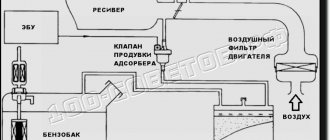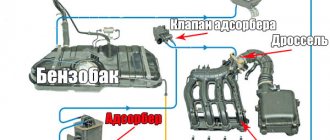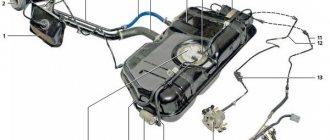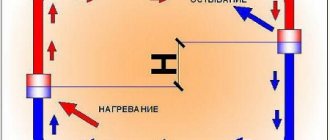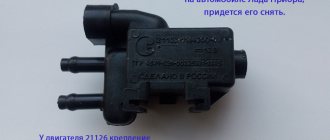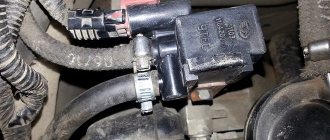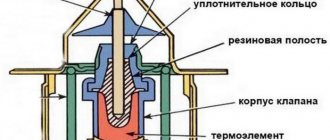Do you need an adsorber? This question worries many Togliatti car owners. The VAZ 2114 adsorber appeared after the introduction of Euro-3 environmental standards, which required the installation of devices on cars that allow them to retain evaporating fuel so that it does not enter the atmosphere. The black cylinder installed on the VAZ on the right in the corner of the engine compartment near the radiator is the VAZ 2114 absorber, the design of which we will consider.
Operating principle of the adsorber
Adsorption is the process of absorption of gaseous substances by solids or liquids. For example, the first gas masks used filters in which the adsorber was activated carbon. The same thing is done in a car, but a little more complicated. The cylindrical plastic body of the adsorber contains a special filler that traps gasoline vapors. The VAZ 2114 absorber does not end with just a can of filler; pipes and valves are connected to it.
The VAZ absorber does not affect fuel consumption in any way; it is installed only to improve the environmental friendliness of the engine. As the gas tank empties, fuel vapors rise to the neck and enter the separator. There they again turn into a liquid state and return to the tank. And the part that did not have time to condense ends up in an adsorber filled with activated carbon, which absorbs harmful gases. This happens when the engine is turned off.
When the engine is running, the VAZ absorber is purged using a special valve, and all gases are burned in the vehicle’s exhaust system. As for fuel consumption, it varies within insignificant limits. The main purpose of the adsorber is only to neutralize gasoline vapors. This is a container with activated carbon, equipped with inlet and outlet hoses for gasoline vapors.
Where is it installed?
As a rule, the adsorber is installed under the hood on the right in the direction of travel of the car, for example, in the VAZ 2110 it is in the form of a barrel.
In other cars, it can be square and installed to the left of the engine (in the direction of travel), under the air duct (Lada Granta), the vacuum brake booster (some Nissan models) or in the radiator area. For VAZ 2114 it is located near the battery and air filter.
On the Volkswagen Passat B3, the adsorber is located under the air filter on the right side in the direction of travel.
Possible malfunctions in the operation of the device
The VAZ 2114 absorber, due to its intended purpose, is susceptible to clogging and at some point may become faulty. Problems are not easily determined and often only by secondary symptoms, for example, increased pressure in the fuel tank. It’s just that gasoline vapors, due to wear of the separator, remain locked in the space of the tank and begin to put pressure on its walls. An increase in pressure can be detected when unscrewing the tank cap - a characteristic hissing sound is heard.
Sometimes the gas tank cap simply shoots out of the neck, which means that the pressure has reached a critical level and the adsorber must be urgently changed. If there is a problem with the adsorber, the engine speed begins to jump up and down. Many car owners write on forums that you can remove the VAZ absorber and not suffer. But everything is not so simple, and there are never unnecessary parts in cars.
Removing the absorber alone is not enough; you need to think about what to do with gasoline vapors that have nowhere to be discharged, and that the ECU may also have to be reconfigured. After all, some types of on-board engine processors find a malfunction in the purging of the fuel system and put the engine into emergency mode, in which it will not be possible to drive normally.
As for malfunctions, the problem area of this adsorbent system is the purge valve. You can repair it yourself. All you need is a flathead screwdriver, but be careful when removing it. The problem is the valve fastening; often it is not metal, but plastic; it is not difficult to break. The mount is located on the engine cover. There are also clamps on the valve itself, which also require a careful approach. We remove them and take out the problematic part.
If you blow into the valve and air comes out of it, this means a 100% malfunction. A normal part will not allow air to pass through. If there is a problem with the valve, the car experiences problems when starting the engine hot, and gasoline consumption increases. If the problem is not corrected, there will be a Check Engine and loss of normal driving dynamics. Failure of the adsorber seal and failure of the purge valve can cause unstable engine operation at idle until it stops.
So, let's move on to valve repair. In its upper part there is an adjusting screw fixed with epoxy resin. Screw the screw in until it stops, counting the turns so that if something happens, you can return the canister valve to its original position. You can drop a little carburetor flushing fluid into the valve fittings. Then we blow it in the open position with compressed air. The repairs are done.
The valve can also wear out due to heat near the radiator, and there is nothing you can do to help it. The quality of the material from which the adsorber valve is made is not the best. The only solution can be to replace or change the location to a cooler one, for example, closer to the adsorber itself.
Determining possible damage
We have figured out why the adsorber is needed, now let’s determine the signs indicating its failure. Considering the quality of fuel at gas stations in our homeland, this part often becomes dirty and fails.
Any malfunction of this mechanism can be easily determined by obvious signs:
Damage to the absorber - the fact that this mechanism of your car has problems can be determined by hearing a hissing sound when opening the tank, it indicates the accumulation of an excess amount of gasoline vapor.
Excessive pressure appears in the tank when you open the lid, there is a moment when the contact area with the external environment is small, and the pressure is quickly “relieved” through it, and the tank “hisses”, similar to a bottle of soda.
In the event of a breakdown, the adsorber is often removed completely, we will discuss how to do this below, but there are no unnecessary parts in the car, it is worth remembering. If you don’t want to remove and gut the ECU, you can try to fix everything yourself. The weakest point in the absorption kit is the VAZ 2114 valve.
Before repairing, you need to make sure that the problem is here:
- Use a flat-head screwdriver to unscrew the fastener on the motor cover (be careful, the fastener is plastic, you shouldn’t break it), and then very carefully remove the clamps.
- We remove the part and blow out the valve. If air does not pass through, then the valve is operational, and the breakdown is elsewhere; if air passes through the valve, then you have found the problem.
A valve failure, in addition to unstable idle speed, will soon give you CheckEngine and significantly increased consumption.
Removal Features
The VAZ absorber is sometimes removed completely. To do this, you need:
- replace the gas tank cap with a leaky one;
- plug the supply and discharge pipes;
- often change the ECU firmware.
As mentioned above, you should not approach the adsorber as an unnecessary thing, and if you decide to remove it, remove it correctly so that the gas tank remains ventilated and not tightly sealed, as if there is an adsorber. Those who convert a carburetor engine to an injection engine have an advantage. If they do not touch the tank pipes, they do not disturb the carburetor ventilation system of the tank, so they do not need an adsorber.
Work principles
Fuel typically evaporates, and in sealed containers like a tank, the evaporation builds up pressure. From the tank, vapors go to the separator, condense and return back to the tank, excess vapors are sent to the adsorber, where the active element absorbs them.
If you have ever stored gasoline in a canister, you have seen how it swells during long-term storage; if you are not so lucky, you could see how it “explodes,” usually on the lid, but on plastic canisters the weakest point is not determined by the lid.
This is what this process looks like when the engine is turned off, when the engine is running, the system opens the adsorber valve (purge valve), when the valve is open, the vapors do not reach the absorber, but are directly blown into the intake pipe, where the engine successfully burns them.
This algorithm is designed to obtain two advantages of the system:
- Increasing the environmental friendliness of the car due to the absorption of fumes.
- Fuel economy when driving (savings are 1%, but present).
As we figured out, gasoline vapors are absorbed by the adsorber or blown into the intake valve, which is responsible for changing operating modes and controlling the system. It switches during system startup, thanks to the engine start controller; during ignition, it turns on the receiver, the sorbent is purged and unabsorbed vapors are immediately sent to the engine, saving every milligram of evaporated fuel.
In addition to the above advantages, the system also does not allow the smell of gasoline into the lard of the car, but such a system also has disadvantages (albeit controversial), motorists complain that it:
- takes up space under the hood;
- is the culprit of unstable operation when broken;
- Expensive.
“We treat” the adsorber
If a breakdown occurs, the problem needs to be solved as soon as possible, there are four options to solve it, depending on the features, you can: replace the valve, replace the adsorber, try to repair the valve, remove the adsorber, we will consider each option in more detail.
Replacing the adsorber
On a VAZ 2114, replacement is very simple, you can go to a service station, but if you do the procedure yourself it will take about 20 minutes. We dismantle the spare part:
- disconnect the hoses from the throttle;
- disconnect the wires and block;
- remove the purge valve and purge and separator hoses;
- unscrew the three bracket bolts;
- the part has been removed.
- We attach a long pipe to the point where vapor is supplied to the blow-off valve;
- We connect a short hose to the fence from the separator;
- put the spare part in place;
- connect the supply hose to the valve;
- install a purge channel (on the engine cover);
- connect the wiring and block;
- place a tube between the valve and the adsorber;
- the work is finished, connect the power and go.
We repair the valve
The valve is clogged due to bad gasoline, before buying a new one, let's try to fix the old one. If a characteristic smell of gasoline appears in the cabin, then the problem is in the valve pipes, they are replaced by simple replacement, and the problem is revealed by a visual inspection, we look at which pipe has burst, buy a new one and install it.
It happens that there is no breakdown, after visually inspecting the pipes, you may find that everything is intact and working, just one pipe has flown out of its place, in this case, you need to put it in place and tighten the clamp.
- We unscrew the adjusting screw, counting the revolutions (it is filled with epoxy resin, it will be easy to find).
- We drip carburetor flushing into the fittings.
- Holding the valve in the open position, we blow it with a compressor.
- We repeat points 2 and 3.
- We put it in place, screw in the adjusting screw to the previously calculated number of revolutions.
Valve replacement
If the valve breaks due to overheating of the radiator, it cannot be repaired; a new part is needed.
The procedure is simple, let's consider it in order:
- We turn off the power to the car and disconnect the KPA plug.
- We loosen the air control inlet pipe, remove it, and move it to the side.
- We bend the fastening, dismantle the valve (remove the fastening no more than 1 cm).
- Lift the valve along the grooves (you need to pull it up).
- We disconnect the fitting, there are two inlets, the first one can be easily removed, the second one will have problems - on the raised fitting, the fixing tendrils are prying up, on the recessed clamp (it’s easy to do with two people, you’ll have to “sweat” alone).
- We install the new adsorber valve in the reverse order.
Removing the adsorber
This is not recommended, but if there is no money (for a new one) and no desire to understand the problem (fix something), it is removed. In addition to the above-described dismantling of the part, three more procedures need to be performed:
- dig into the ECU (reflash);
- seal the pipes leading to it;
- replace the tank cap (it needs a leaky one).
- The VAZ 2114 adsorber is an important part; it should not be removed.
- You now know how to replace a part, determine if it is broken and try to repair it, so it’s better to do just that.
- If you decide to remove it, remember, now the car is environmentally friendly “Euro 1”, later problems may arise with this.
Useful video
You can get additional information about the design of the adsorber and options for replacing it from the video below:
According to the requirements of new environmental standards that limit the content of harmful substances in exhaust gases, vehicles must be equipped with an EVAP system. This equipment prevents harmful fuel fumes from entering the atmosphere. The main function in the fuel vapor recovery system is performed by the adsorber. Some people underestimate the importance of this element in the operation of a car. However, a malfunction of this seemingly minor component can lead to damage to the fuel pump and affect the operation of the entire engine. Therefore, experts recommend checking the adsorber valve when signs of engine malfunction appear.
Price policy
Speaking about the Grant adsorber purge valve, which today can be bought in all large and not very large places where spare parts for the Russian automobile industry are sold, it is impossible not to notice its pleasant price. The Grant adsorber valve, the price of which is equivalent to the probability of its failure, allows for independent replacement and is the simplest mechanism.
Therefore, compliance with Lada Grant environmental standards is the work of man. The adsorber has become a part that, in addition to caring for the environment, can significantly reduce fuel consumption and improve the removal of exhaust gases.
Purpose and principle of operation of the adsorber purge valve
Absorber valve diagram
The EVAP system is installed on gasoline internal combustion engines to prevent fuel vapors from entering the atmosphere. The canister purge solenoid valve is an element of this system. Therefore, to find out what the canister valve is for and how it works, it is important to understand the operating principle of the entire system. The design of the adsorber is a container filled with an adsorbent, most often activated carbon. The device is connected to the fuel tank and the control valve of the vehicle using special tubes.
The canister valve is installed between the intake manifold and the canister and performs the function of ventilation.
Gasoline vapors formed in the fuel tank penetrate the separator, where they condense and are discharged back into the tank. Some of the vapor does not have time to condense in the separator and enters the adsorber through the steam line. In the filter system, they are absorbed by activated carbon, accumulated and then supplied to the intake manifold when the engine starts. The process of absorption of fuel vapors takes place only when the engine is turned off. When the car is running, the electronic control unit opens the canister purge solenoid valve, through which air enters and thus ventilation occurs. In this case, the accumulated condensate along with air is sucked out of the adsorber and again enters the engine, where it is burned out. The canister valve provides ventilation to the entire mechanism and directs fuel condensate back to the engine.
Components
In fact, this is a large plastic jar with activated carbon inside, because it is this composition that perfectly fights gasoline vapors. The main parts can be described as follows:
- Separator + gravity valve
- Pressure meter
- Filter part (usually carbon)
- Connecting tubes
- Solenoid valve
As you can see, there is absolutely nothing complicated. Separator - serves to catch part of the gasoline, then sends it back to the tank. Gravity valve - almost never used, but it is needed in emergency situations, for example during accidents, it prevents fuel from overflowing from the tank (for example, when a car overturns).
The pressure sensor is a very necessary thing - it monitors the pressure of gasoline vapors inside the tank, if necessary, it opens and resets it, preventing the structure from being damaged.
The filter part is, as I wrote above, a large jar into which coal powder is poured, in fairly large granules. This is done so that vapors can pass and condense freely.
Connecting tubes are needed to connect all the main parts, filters, sensors and valves, I think this is clear.
Solenoid valve - used to switch modes for capturing gasoline vapors, we will talk about it in more detail below.
Malfunctions of the adsorber valve and their elimination
Almost continuous operation of the fuel vapor absorption system canister can cause damage to the purge valve. A malfunction of the canister valve often leads to damage to the fuel pump. Due to poor ventilation of the adsorber, gasoline accumulates in the intake manifold, the engine loses power, and fuel consumption gradually increases. This may cause the engine to stop completely. The operation of the entire vehicle depends on how the adsorber valve works.
How to check the functionality of the canister purge valve?
Checking the absorber valve
In order to notice and correct problems in time, regular checks of the adsorber valve are necessary. In this case, a breakdown can be identified by certain indirect signs. When the engine is idling or in cold weather, the vapor absorption system makes characteristic sounds, like the canister valve clicking. Some people confuse this sound with a faulty timing belt, rollers or other parts. You can check this by sharply pressing the gas pedal. If the sound has not changed, it means the canister valve is clicking. Experts can explain what to do if the canister valve knocks too loudly. To do this, you need to tighten the adjusting screw, and first it is cleared of epoxy resin.
The absorber valve can be adjusted.
The screw turns approximately half a turn. If you tighten it too much, the controller will generate an error. This adjustment of the adsorber valve will make its operation softer and the knocking noise quieter. However, how to check the adsorber valve for damage? Valve failure can be determined using an error diagnostic system or mechanical testing. Electronic error codes are stored in the controller's memory and indicate electrical damage. To check the valve, it is recommended to pay attention to errors generated by the controller, such as “open circuit of the canister purge valve control circuit.” Signs by which a malfunction of the adsorber valve can be mechanically determined:
- The appearance of dips at idle speed of the engine.
- Very low engine thrust.
- There is no sound of valve operation when the engine is running.
- A hissing sound when the gas tank cap is opened indicates a vacuum in the system. This is a sure sign of a malfunction in the adsorber ventilation.
- The appearance of a fuel smell in the car interior. However, its appearance can also be caused by other reasons.
Addresses of companies providing installation/replacement services (Moscow, St. Petersburg, Kyiv region)
| № | Name | Address |
| 1. | "Diesel Master" | Russia, St. Petersburg, Moskovskoe highway, 13A, Zvezdnaya metro station |
| 2. | "Author+" | Russia, St. Petersburg, Mineralnaya str., 13O, Vyborgskaya metro station |
| 3. | "Service Team" | Car service, automatic transmission repair, tire side cut repair, car air conditioner repair, Strogino metro station, Marshala Proshlyakova street, 12k1s1 |
| 4. |
Car services, repair of electronic vehicle control systems, repair of electrical equipment, repair of fuel equipment for diesel engines, metro station Gagarina Square, Vavilova, 13a, 1st floor
5. “Kulibins” Kyiv, st. Borova 2/38
6. “Renault-Life” Kyiv, st. Novokonstantinovskaya, 1 G
Do-it-yourself absorber valve replacement
If signs of malfunction are detected, the valve will need to be repaired or replaced. The adsorber valve is inexpensive and easy to replace. To dismantle you need to have a pair of Phillips screwdrivers and know where the canister purge valve is located. Operating procedure:
The markings on the old and new valves must match.
- Open the hood and find a cylindrical device - an adsorber.
- Remove the negative terminal from the battery.
- Disconnect the wire block by pressing the latch and pulling it towards you.
- Loosen the valve.
- Remove the fittings under the latch and disconnect the hoses.
- Remove the valve together with the bracket from the adsorber.
- The new valve is installed in the reverse order.
Thus, even such a small element as the adsorber valve performs important functions and its malfunction can seriously disrupt the operation of the entire engine. Therefore, it is important to monitor the condition of your car and carry out diagnostics on time.
